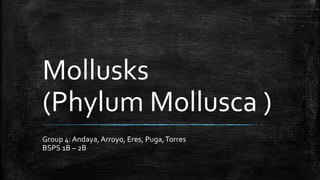
Mollusks
- 1. Mollusks (Phylum Mollusca ) Group 4: Andaya, Arroyo, Eres, Puga,Torres BSPS 1B – 2B
- 2. Description ▪ The molluscs (Americans spell it as ‘mollusks’) constitute one of the largest phyla of animals, with close to 112,000 species to be found worldwide. The scientific study of mollusks is known as malacology . The mollusks first appeared during the Cambrian period of the evolutionary calendar. The world mollusca has its root in the Latin word molluscus meaning ‘thin shelled’ which in turn is derived from the root Latin
- 3. ▪ This is a description of their main characteristic -all mollusks have a soft body, which ( with the exceptions of from certain families) is generally protected by an external, calcium- shell. In the octopuses and sea-slugs completely absent where as in squids it is located internally.
- 4. Main characteristics of Mollusca ▪ All modern mollusks have the same fundamental body plan. There are three distinct body zones: a head- foot, a visceral mass and a mantle. Some common features are :
- 5. 1)Bilaterally symmetrical. 2)Body has more than two cell layers, tissues and organs. 3)Body without cavity. 4)Body possesses a through gut with mouth and anus. 5)Body monomeric and highly variable in form, may possess a dorsal or lateral shells of protein and calcareous spicules. 6)Has a nervous system with a circum- oesophagal ring, ganglia and paired nerve chords. 7)Has an open circulatory system with a heart and an aorta. 8)Has gaseous exchange organs called ctenidial
- 7. The Class Bivalvia • The bivalves (meaning "two- shells") are perhaps the most well known mollusks simply because of their history as a source of food. Clams, mussels, oysters and scallops are all bivalves. • The bivalve may either burrow through the bottom, or attach itself to the substrate with glue-like strings called "byssal threads.“ • Most bivalves feed by filtering organic particles from water, and therefore do not have a radula. • The shell is generated by the mantle from the inside. Pearls are made by clams, oysters and mussels
- 9. The Class Cephalopoda • Although we usually think of Mollusks as benthic (bottom dwelling), the cephalopods have taken to a nektonic (swimming), rather than benthic, existence in the ocean. • The cephalopods may not seem very closely related to the other mollusks, but physiologically, they are similar in internal construction. • Perhaps the most obvious difference between most cephalopods and other mollusks is the apparent lack of a shell. • Cephalopods have the most well developed nervous systems of all mollusks, as well as the most well developed eye. • The cephalopod eye is one of the most notable examples of convergent evolution in all of the animal world
- 10. The class of Gastropoda million years ago. No other class has as many species (more than 50,000) or are as widely collected. • The Class Gastropoda includes the snails and slugs. Most gastropods have a single, usually spirally coiled shell into which the body can be withdrawn, but the shell is lost or reduced some important groups. • Gastropods are characterized by "torsion," a process that results in the rotation of the visceral mass and mantle on the foot. • Gastropods are dioecious, and some forms are hermaphroditic. Hermaphroditic forms exchange bundles of sperm to avoid self-fertilization
- 11. The class of Monoplacophora • Monoplacophorans are small and limpet-like, having a single, cap-like shell. Some organs (kidneys, heart, gills) are repeated serially,. • The word Monoplacophora is derived from three Greek words monos=one, plax=plate and pherein=bearing. So it includes animals having only one plate. It does not have any order.The characteristics of it are listed as below. Examples :- Neopilina galatheae
- 12. ▪ They have bilaterally symmetrical and segmented body. They have shell made up of single piece or valve.They have head without eyes and tentacles.They have ventral and flat foot.They have mantle which encircle the body as a circular fold of the body wall.They have external and serially arranged gills.They have five pairs of serially arranged nephridia.They have sex organs in two separate bodies.
- 13. The Scaphopoda distinctive group of mollusks commonly known as the "tusk shells" because their shells are conical and slightly curved to the dorsal side, making the shells look like tiny tusks • Scaphopods live their adult lives buried in sand or mud, with their head end pointed downwards. Only the narrow posterior end of the shell sticks up into the seawater for water exchange and waste expulsion.
- 14. ▪ The scientific name Scaphopoda means "shovel foot," a term that refers to the "head" of the animal, which lacks eyes and is used for burrowing in marine mud and sediments.The most distinctive feature of scaphopods is that the tubular shell is open at both ends, not just one end as in most mollusks.
- 15. Significance ▪ Mollusks, which include land snails, freshwater snails, mussels, clams, and slugs, are vital to healthy ecosystems. Land snails, for example, not only provide food for a host of small mammals and birds, but they play vital roles in recycling forest nutrients. Freshwater snails also provide food for fish, including native trout and salmon, and are also important recyclers of plant and animal waste, essentially keeping water clean and healthy.
- 16. ▪ Mollusks are of general importance within food chains and as members of ecosystems. Certain species are of direct or indirect commercial and even medical importance to humans. Many gastropod species, for example, are necessary intermediate hosts for parasitic flatworms (classTrematoda, phylum Platyhelminthes), such as the species that cause schistosomiasis in humans. Most bivalves contribute to the organic turnover in the intertidal (littoral) zones of marine and fresh water because, as filter feeders, they filter up to 40 liters (10 gallons) of water per hour.
